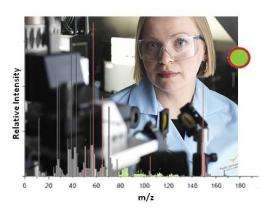Scientists Characterize Poorly Understood, Climate-Influencing Atmospheric Particles

(PhysOrg.com) -- Two very different forms of climate-influencing particles do not behave as expected, according to scientists at Pacific Northwest National Laboratory and Imre Consulting. The team's measurements show that when the particles mix, they create new, layered particles, not the expected mixtures. The team also found that one form adsorbs onto the other, creating bigger particles that do not behave as predicted in climate models. This study led to an invited paper in a special issue of Proceedings of the National Academy of Science.
Whether created by nature or humankind, tiny particles in the atmosphere influence the planet's climate. In particular, scientists are concerned with primary and secondary organic aerosols. Abundant in the atmosphere, these particles are derived from fossil fuels and other sources. Scientists aim to model the effect of these particles and other factors to predict the effect of various remediation strategies on climate. Studies like this one are essential to understand the processes that determine the numbers and properties of particles, leading to more accurate models and predictions.
The team generated three different types of particles inside large reaction chambers and analyzed the particles using SPLAT II, a single particle mass spectrometer, located in DOE's EMSL, a national scientific user facility at PNNL. Using the depth-profiling method, the researchers obtained data about the morphology of all three-particle types.
First, the team created SOAs formed in the presence of particles composed of hydrophobic (or water-fearing) dioctyl phthalate (DOP), a proxy for exhaust particles. The team found that the SOA material forms a coat on top of the DOP particles. When the team looked closely at these particles, they found that the final particles obtained two coatings: a DOP core was coated with a thick SOA layer that was coated with a very thin DOP layer. Next, they created particles by making pure SOA and coating them with DOP. They found these particles had a stable DOP coat on top of an SOA core.
Finally, they generated SOA particles in the presence of DOP vapor and to their surprise, found the newly formed SOA particles to be coated with a layer of DOP that is about 4 nm thick, and increases the particle mass by 12%.
The team was honored to be invited to contribute a paper on these results to the Proceedings of the National Academy of Sciences, said Dr. Alla Zelenyuk, the principal investigator on this study and a chemist at Pacific Northwest National Laboratory. The paper will appear in a special issue on atmospheric science.
The scientists are continuing their research into measuring the effect of the hydrophobic coating on secondary organic aerosols.
More information: Vaden TD, C Song, RA Zaveri, D Imre, and A Zelenyuk. 2010. "Morphology of Mixed Primary and Secondary Organic Particles and the Adsorption of Spectator Organic Gases during Aerosol Formation." Proceedings of the National Academy of Sciences. www.pnas.org/
Provided by Pacific Northwest National Laboratory


















